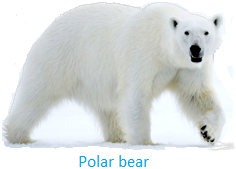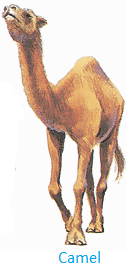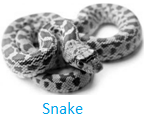Animals Living on Land
The animals, living on land are called terrestrial animals. Their bodies are suited to live on land.
They breathe with the help of lungs. Some of them have sharp teeth and claws to catch their prey. Most of them have legs to move, which also help them to run fast to catch their prey or to protect themselves. Their senses are well developed. This helps them to look for food and escape from enemies.
Lion, cow, camel, deer, buffalo, tiger, etc. are terrestrial animals. Some terrestrial animals like snake and earthworm crawl.
|
In the polar region, animals have to face harsh winters. Animals living in these regions have thick hair coat on the skin and fat under it keep them warm. Such animals are polar-bear, yak etc. A polar bear is adapted to live in these conditions. Animals living in cold regions have thick hair on the skin and fat under it to keep them warm which protects it from the cold. Such animals are polar-bear, penguin, yak, etc. Penguins huddle up together to keep themselves warm. |
|
Deserts are very hot during the day, but become cold at night. Animals have to adapt to these conditions, and also have to live with very little water. Animals living in a desert have skin with less hair. Camel is an example of desert animals they have thick skin which protects it from the sun and also from the cold. Fat is stored in its hump. It lives on this fat and so can survive without food or water for days. |
Some animals such as lizards, snakes and rats cannot bear cold.
During summer they eat as much as they can and get fat. Then during winter they sleep in caves or holes under the ground and live off the extra fat. This is called hibernation.
From Animals Living on Land to HOME PAGE
Recent Articles
-
What Is Plasma? | Blood Plasma | Proteins | Nutrients | Cholesterol
Nov 07, 25 10:29 AM
Blood is a mobile fluid which is a connective tissue and is derived from the mesoderm like cell any other connective tissue. Colour of blood is reddish and that flows inside the blood vessels by means… -
Disorders of Respiratory System | Tuberculosis | Pleurisy | Emphysema
Oct 28, 25 11:39 PM
Tuberculosis is very common disease and is caused by a type of bacteria called Mycobacterium tuberculosis. This disease causes different trouble in the respiration and infection of several parts of th… -
Regulation of Respiration | Respiratory Centres | Inspiratory Area |
Oct 14, 25 12:13 AM
Respiratory Centre is the area that controls the rate of respiration and it is observed to be located in medulla oblongata and pons. Respiratory Centre has the following will dispersed components like… -
Explain Transport of Gases | External Respiration | Tissue Respiration
Oct 09, 25 11:35 PM
In humans gaseous exchange is completed in the following ways the steps are - External Respiration or Breathing - Breathing in false taking in of Oxygen and giving out of carbon dioxide in the body. M… -
Kind and Number of Teeth | Location of Teeth in Mouth | Care of Teeth
Sep 11, 25 12:52 AM
Kind and Number of Teeth









New! Comments
Have your say about what you just read! Leave me a comment in the box below.